NIH used bats from Maryland zoo for 2018 Wuhan bat virus study
Pre-COVID-19, UNC's Ralph Baric got bats from a private zoo in Ft. Detrick's backyard to study a Wuhan Institute of Virology bat virus
I thought a camel near the Army’s top-level biolab was odd, then I learned it was supplying an NIH lab with bats.
The U.S. Army’s Fort Detrick does virus research on base, including on bat coronaviruses, Ebola, and also Middle East Respiratory Syndrome (MERS).
You know, the deadly stuff.
The MERS virus has a connection to camels, so, last year, when I saw there was a camel at a private Maryland zoo, located mere miles from the Army’s top-level research lab, I jokingly posted that I was going to start buying tin foil hats in bulk.


Camels are known reservoirs of the deadly MERS virus, meaning MERS “grows” in/can infect camels and humans. MERS, which has no known cure, is studied in biolabs around the world and in the U.S.
Ft. Detrick’s special lab—a level 4 biosecurity lab (BSL-4) where researchers at the U.S. Army Medical Research Institute of Infectious Diseases (USAMRIID) wear positive-pressure space suits— has been studying the MERS virus for years.
Wasn’t it odd, I thought at the time, that there was a camel, or two, nearby?
But, then it got a little batty…
Evidently, Maryland’s Catoctin Wildlife Preserve and Zoo doesn’t just house camels, it has bats.
Remember Netflix’s Tiger King? Yeah, this is not that.
But, I wondered, have we stumbled upon the old hiding-in-plain-sight operation?
In the Twitter comments under my camel tweet last fall, a researcher with the international group of scientists and sleuths known as D.R.A.S.T.I.C. (Art @ico_dna, now off Twitter), pointed out that the private Maryland zoo supplied bats to an NIH-funded research lab in Montana in 2018.
Wait, what?
I missed it at the time, but the Maryland zoo’s map also shows a bat exhibit, in addition to its camel exhibit.
And, that researcher was right, this Maryland zoo is listed as an official bat supplier for NIH-funded covid research.
Zooming in a little more closely on the zoo's map, you can see the “Neotropical Bat Building”:
NIH funding, Maryland bats, and a Wuhan bat virus
The reference section of this 2018 scientific paper, explains the folks at the Catoctin Wildlife Preserve and Zoo supplied U.S. coronavirus scientists with bats, specifically Egyptian fruit bats. For this study, they were shipped out to a special NIH lab in Montana.
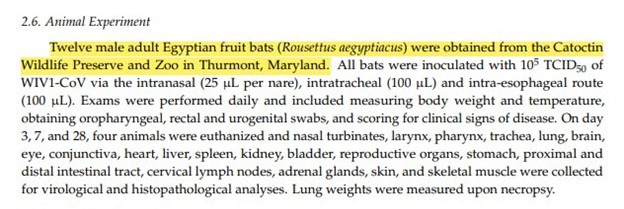
The 2018 study says, “Twelve male adult Egyptian fruit bats (Rousettus aegyptiacus) were obtained from the Catoctin Wildlife Preserve and Zoo in Thurmont, Maryland.”
In the study’s acknowledgements section, we again see the researchers got their animals (bats) through the private Maryland zoo. (They funded the study through NIH and Dr. Anthony Fauci’s NIAID, including though NIAID grant AI089728 given to U. of Minnesota’s Fang Li, who, interestingly enough, is not listed on this study.)
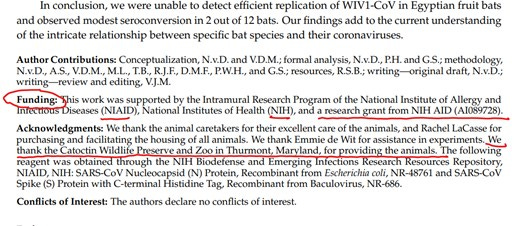
Here’s a photo I found of the Maryland zoo’s Neotropical Bat Building:

I also found this photo, which doesn’t scream luxury bat housing, but did confirm what type of bat they house at the Catoctin Wildlife Zoo: there’s the Egyptian fruit bat in the exhibit photo.
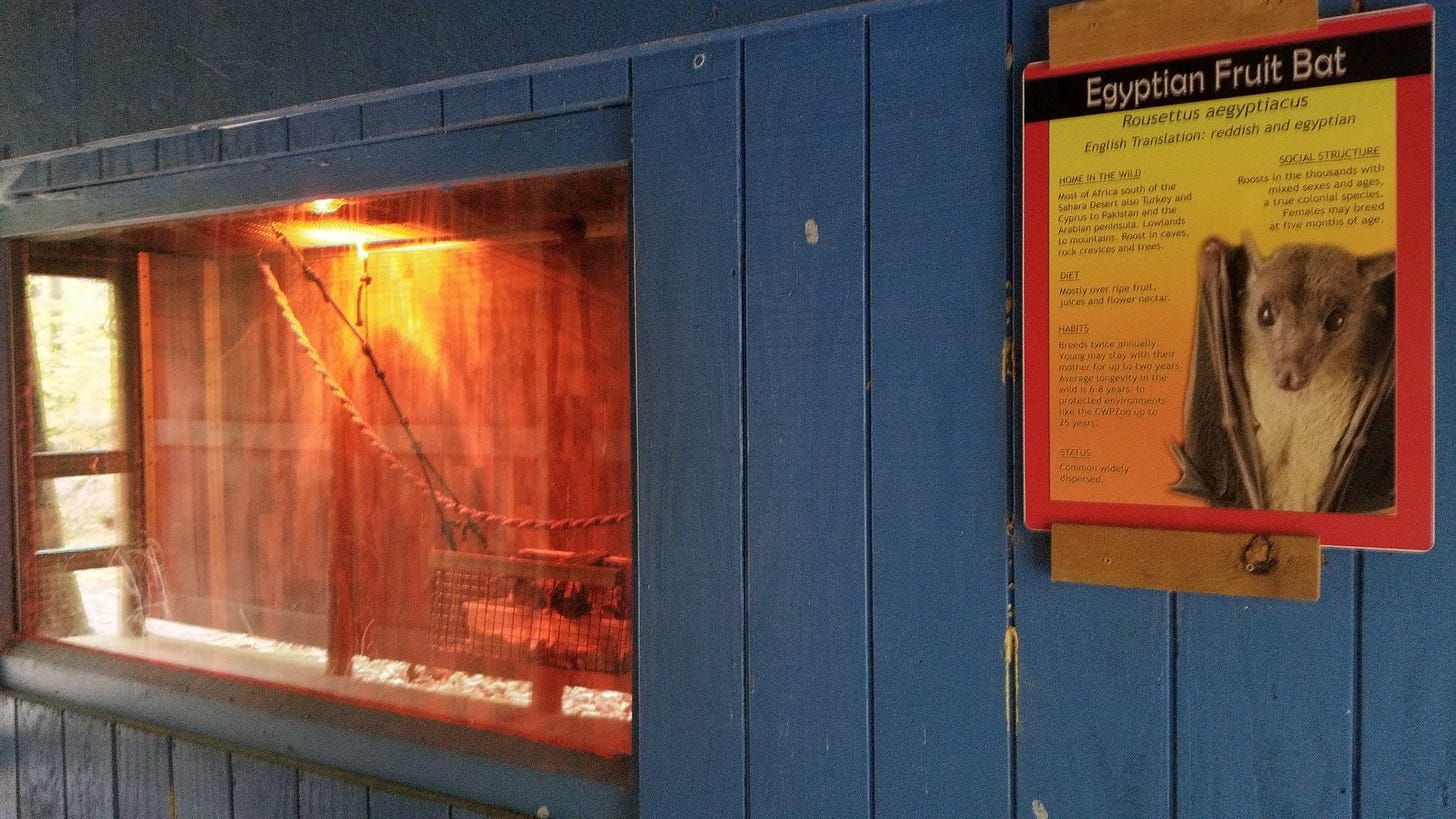
Dr. Ralph Baric used the Maryland zoo’s bats for covid research
Turns out, U.S. bat coronavirus expert UNC’s Dr. Ralph Baric was an author on that 2018 Montana-based coronavirus study using Maryland’s fruit bats.
As to what they were studying:
He, and his NIH-funded colleagues, were using the Maryland bats to study a bat virus he got from China’s Wuhan Institute of Virology (WIV).
Maybe you’ve heard of that shop?
The NIH-funded scientists were trying to get a “SARS-like” bat virus from the WIV’s virus supply stock to stick to/grow in/infect Egyptian fruit bats in a U.S. lab.
In 2018, Dr. Baric, NIH researcher Dr. Vincent Munster, and their colleagues were studying Egyptian fruit bats (from Catoctin’s zoo) in a BSL-3 lab in Montana, at the NIH-funded Rocky Mountain Laboratories (RML). (The Montana RML also houses a BSL-4 lab, like Ft. Detrick’s with the moon suits, but the Baric/Munster paper says this work was done in a BSL-3.)
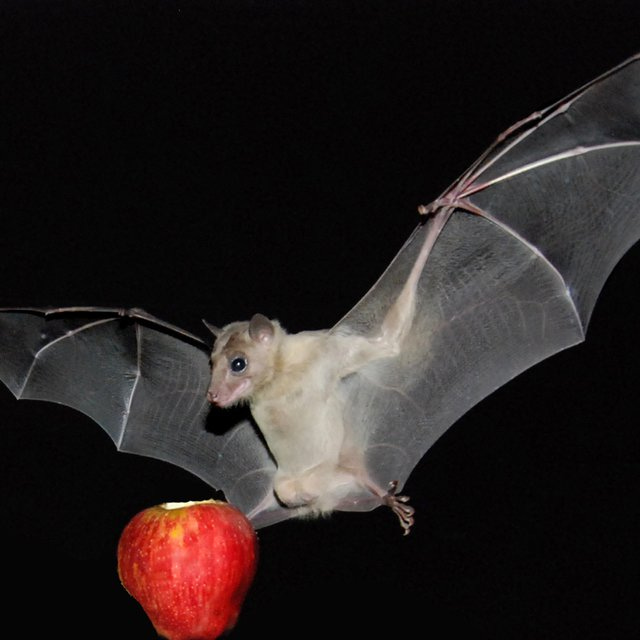
Now, remember this is pre-COVID-19. They were working here on a “SARS-like” virus similar to the first SARS virus, the one that emerged in China in 2002.
Their SARS-like virus experiment with the Maryland bats apparently DIDN’T work, it did not cause a “robust infection” in the bats… at least not in 2018, and they told the world that in their published paper.
As I mentioned above, the coronavirus Dr. Baric and his colleagues were studying was a Wuhan Institute of Virology-held bat virus, which in 2012 was collected by a team from the WIV. The Wuhan researchers named it WIV-1, or as Baric’s paper calls it “WIV1-CoV” (the CoV means coronavirus).
A recent interview of Wuhan’s bat lady, scientist Dr. Shi Zhengli, and her colleagues provides us more information on the September 2012 origins of WIV-1. It is, they say, a coronavirus from horseshoe bats found in China’s Kunming bat caves, then taken back to the WIV lab and shared with folks around the world, or at least shared with UNC’s Dr. Ralph Baric and NIH’s Dr. Victor Munster.
If the viruses don’t attach/infect the bats, researchers can’t grow them, and can’t make vaccines and treatments and drugs against these viruses. This is something apparently everyone wanted to do, in case a SARS-like virus jumped into humans and caused a pandemic.
So in 2018, what do U.S. researchers who want to study Chinese bat viruses do if they cannot find bats in the U.S. to test/grow the viruses on?
I don’t know.
They haven’t told us.
Did they go to computer modelling?
Did they take their research abroad?
Did they figure out a way to modify the SARS-like virus(es) to make them infect Egyptian fruit bats so they could be studied in the U.S.?
Coming Soon …
Something I’m going to explore (in another post) is that international scientists have reported, in peer-reviewed papers, that our new pandemic virus, SARS-CoV-2, the virus that causes COVID-19, DOES in fact stick to/infect the Egyptian fruit bat.
Given that Dr. Baric’s 2018 paper showed the “SARS-like” WIV-1 virus DID NOT stick to/infect those bats, is it noteworthy that the SARS-CoV-2 virus DOES stick to the Egyptian fruit bats?
I plan to explore that and more.
I didn’t call it Batsh*t Crazy for nothing.
Batsh*t Crazy is researched and written by an American researcher, following history’s footnotes to try and uncover the truth about how, and maybe why, COVID-19 began.

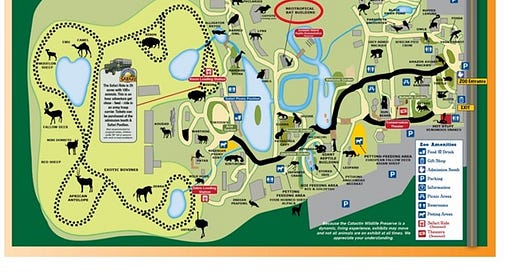




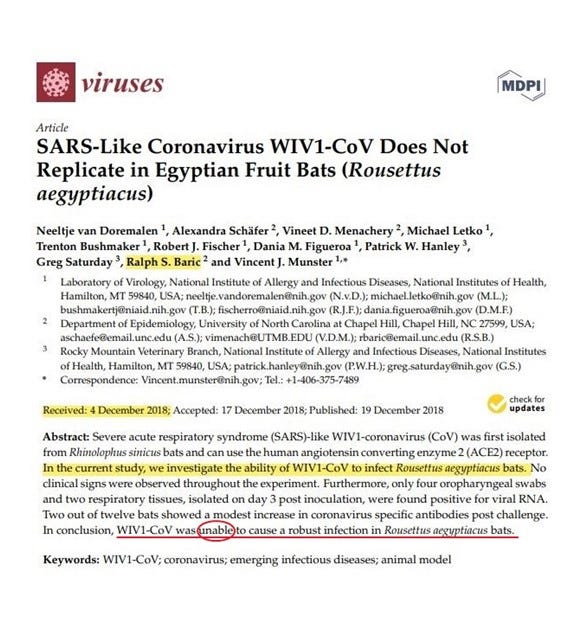


Why indeed, also don't forget the deer.
Very interesting discovery, makes me wonder what other private sources of animals are involved in supplying research labs.
As for Fang Li, a prolific publisher, named in hundreds of papers with thousands of citations, how odd of Baric et al to mention the grant but not the world famous virologist recipient who is very well know to them.
An aside: I can't be alone in experiencing a bit of a shiver on noticing the zoo's Neotropical Bat Building is adjacent to its "Jurassic Park" area. Gulp!